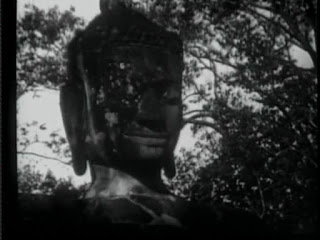For the following two films, critical consensus -- at least in the form of IMDb ratings and comments -- seems to go one way. As you'll see from these reviews, we go another.
Grade: D+
The Shadow of Silk Lennox is the fifth film with Lon Chaney Jr. in this box set, though not quite the last (since Bride of the Gorilla will show up in the final subset, 50 Sci-Fi Classics).
Naturally Chaney is our title character, a deceptively genial gangster whose moniker comes from his corny catchphrase: whenever anyone asks after him, the reply is that things are "smooth as silk". Uh-huh. Owner of several nightclubs, he's also the mastermind behind the heists and hold-up jobs plaguing the city of Wherever-This-Is.
Most of the action takes place in and around the clubs, though, where two young lovebirds (Dean Benton and Marie Burton) twitter away on stage. Once offstage, they inevitably get mixed up in Lennox's tangled web.
Soon enough, you've got murder, deception, and the obligatory racist caricature.
IMDb's reviewer base seems to have decided The Shadow of Silk Lennox is uncommonly poor, but we didn't much mind it. Maybe we haven't seen enough 1930s gangster films (not that we feel compelled to go much deeper than we already have), but while a weaker effort than some, it's hardly a disaster -- just a by-the-numbers affair, plus one or two twists we frankly didn't see coming until they were almost on top of us.
It also amused us to see either (a) what passed for nightclub entertainment in the 1930s, or (b) what the makers of this film thought would pass for nightclub entertainment in the 1930s: not sure which. While you can't hear the music in the screenshot, the faces speak volumes!
Grade: F
You know, we sort of enjoyed ZaSu Pitts in Strangers of the Evening. Her screentime was limited to a light sprinkling, yielding a film with just the right amount of her forlorn persona: that is, enough to add a quirky twist to proceedings, but not so as to wear out its welcome.
But with a much larger role in The Crooked Circle, Pitts's mournful presence soon becomes a plague. It's hard to imagine an audience to whom her constant handwringing and cries of "Oh!" were a laff riot; for us, they were infuriating.
Same goes for her catchphrase, "Something always happens to somebody!" Sure, we've seen films in which a repeated line becomes a kind of leitmotif that gets funnier as it recurs in more and more unlikely contexts -- but here, it was an irritating contrivance.
(Maybe she should swap with Silk Lennox? Come to think of it, a catchphrase transplant would improve both films.)
And contrived is the word that defines The Crooked Circle, a movie that really seems to have no idea what it's doing or why. "Good old fashioned fun!" says a typical review on IMDb, but that wasn't our experience, to put it politely: this film is torture, awkward and interminable, like watching a bad improv company's attempt at creating an hour-long comic mystery on the fly.
The pacing is trash, the direction and editing are awful, and as K. quite rightly noted, the actors often seem to have no idea what their lines mean. Characters come and go with little explanation, transitions are botched, and cutaways serve to confuse the narrative without intensifying it.
Oddly enough the plot itself -- concerning a clash between a society of amateur detectives and the titular criminal cabal -- isn't so bad, or at least makes a kind of sense, with a decent-if-foreseeable twist near the end. But the script lacks formal rhythm, and whatever energy it picks up is soon squandered: a clever sequence in which hero Brand Osborne (Ben Lyon) gets outfoxed is immediately followed by a scene in which the consequences of that outfoxing are instantly undone. Way to keep the tension, bro.
Some faint specks of light (we can't quite call them bright spots) emerge in The Crooked Circle. Of the two lines of dialogue that graduate to the level of vaguely amusing, one is Pitts's deadpan definition of a myth as "a female moth", and the other comes in a policeman's description of his hard-bitten criminal foes:
"They wasn't born, they was quarried."
Another faint speck is Irene Purcell, underutilized but still appealing as Thelma, Osborne's cipher of a girlfriend. Her short-lived career seems to be fondly remembered by a few film buffs, and it's a shame this turkey was her last role.
None of this is enough to salvage this car crash of a movie -- and we haven't even talked about the tired spooky-old-house and famous-criminologist tropes in which it traffics. (On the latter tip, that's C. Henry Gordon above as Yoganda, the "Indian" sleuth whose name inevitably gets misheard as an African country.)
All the more bizarre, then, that The Crooked Circle holds a unique honor: if IMDb is telling the truth, it was the first feature film ever broadcast on television. What an inauspicious start for the new medium!



























































